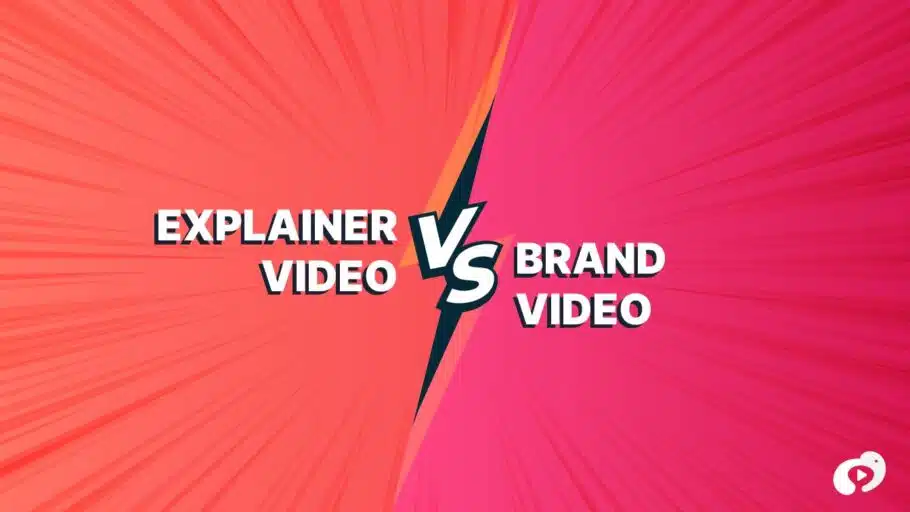Last Updated on June 4, 2024
Article Contents
Estimated reading time: 9 minutes
In today’s crowded digital world, where products and services flood the market, businesses are turning to video content to meet their marketing objectives. Amid this video revolution, terms like “explainer” and “brand videos” often surface. While they are sometimes used interchangeably, they are distinct tools with unique functions. To make the most of these video marketing strategies, it’s essential to grasp their differences, similarities of Explainer video vs Brand video and how each can benefit your brand.
Both explainer and brand videos share commonalities, yet they serve distinct purposes. Understanding these differences is crucial to effectively utilize both tools for your marketing endeavors. So, let’s explore into what these terms mean, how they can enhance your business, and which might be the optimal choice for your specific needs.
Quick Overview Table: Explainer Video vs. Brand Video
| Aspect | Explainer Video | Brand Video |
| Primary Objective | Educate, clarify, and inform | Build brand identity and trust |
| Content Focus | Information and problem-solving | Storytelling and emotional connection |
| Audience Engagement | Clarity and education | Emotional resonance and brand connection |
| Content Structure | Problem-solution-CTA format | Narrative storytelling and customer stories |
| Visual Elements | Visual aids and animations | Cinematography and visual storytelling |
| Call to Action (CTA) | Direct, action-oriented CTAs | Indirect, brand-affinity CTAs |
Explainer Video vs. Brand Video – Definitions
Explainer Video Definition
Explainer videos are concise and focused video content pieces designed to simplify complex concepts, products, or services. They aim to educate and engage the audience by presenting information in a clear and digestible format. In the B2B tech context, explainer videos often break down intricate technical details into easily understandable terms.
For further insights into the world of explainer videos, delve into our comprehensive guide, “The Ultimate Explainer Video Handbook”
Brand Video Definition
Brand videos, on the other hand, are a broader category of video content with a primary objective of building and promoting a brand’s identity, values, and reputation. These videos may encompass a range of narratives, from the brand’s history and journey to its core values and the impact it creates. In the B2B tech sector, brand videos serve to humanize and establish a strong brand presence.
How is an Explainer Video Different from a Brand Video?
- Focus and Purpose Of Video Content
- Content Structure
- Audience Engagement
- Visual Elements in Video Production
- Call to Action (CTA)
In this section, we will dissect the core distinctions between explainer and brand videos, shedding light on their unique characteristics, purposes, and the specific scenarios where one outshines the other.
1. Focus and Purpose Of Video Content
Explainer videos are laser-focused on delivering information. Their primary goal is to educate and simplify complex topics, making them ideal for introducing new tech products, explaining software functionalities, or illustrating intricate processes.
Brand videos, on the other hand, have a broader purpose. They aim to create an emotional connection between the audience and the brand. While they may include informative elements, their primary focus is on storytelling and brand identity.
2. Content Structure
Explainer videos follow a logical and structured sequence. They typically identify a problem or challenge, present a solution (usually the product or service), and conclude with a call to action (CTA).
Brand videos, in contrast, often adopt a narrative structure. They may not always present a problem and solution but instead tell a story that aligns with the brand’s values and vision. Customer testimonials and success stories are common elements in brand videos.
3. Audience Engagement
Explainer videos engage the audience through clarity and informative content. They aim to provide answers and solutions to specific queries or challenges, making them a valuable resource for tech-savvy B2B audiences.
Brand videos focus on emotional engagement. They aim to create a lasting impression by evoking feelings, building trust, and fostering brand loyalty. These videos resonate with audiences on a personal level.
4. Visual Elements in Video Production
Explainer videos rely heavily on visuals, animations, and graphics to simplify complex ideas. They aim for clarity and understanding, making them visually engaging.
Brand videos prioritize cinematography and visual storytelling. They use aesthetics, creative shots, and artistic elements to convey the brand’s personality and values. Visuals in brand videos often aim for emotional impact.
5. Call to Action (CTA)
Explainer videos typically include a clear and direct CTA, encouraging viewers to take specific actions related to the explained concept or product, such as signing up, trying a demo, or making a purchase.
Brand videos may have indirect CTAs, such as encouraging viewers to connect with the brand, explore its offerings, or share their own brand experiences. The call to action is often subtler and focused on building brand affinity.
In the B2B tech marketing landscape, the choice between explainer and brand videos depends on the specific goals, target audience, and desired impact. While explainer videos are excellent for conveying technical information, brand videos excel in building long-term brand relationships and trust.
When looking for an explainer video agency in Delhi, it’s essential to find a team that understands your brand’s unique needs and can simplify complex concepts effectively.
Benefits of Brand Videos
- Brand Awareness
- Credibility
- Emotional Connection
- Humanizing the Brand
- Versatility
- Long-Term Impact
Brand videos offer a range of unique advantages in the B2B tech marketing sphere:
1. Brand Awareness
Brand videos help tech businesses establish a strong brand presence and make a memorable impact on their audience.
2. Credibility
By showcasing the brand’s values, expertise, and success stories, brand videos enhance the credibility and reputation of the business.
3. Emotional Connection
These videos create an emotional bond with the audience, fostering loyalty and a sense of belonging.
4. Humanizing the Brand
Brand videos humanize tech brands, making them relatable and personable, even in the context of complex technology.
5. Versatility
Brand videos can serve multiple purposes, from introducing the brand to showcasing its innovative solutions and sharing customer testimonials.
6. Long-Term Impact
Unlike explainer videos that focus on specific information, brand videos aim to leave a lasting impression and build enduring brand relationships.
In the competitive B2B tech sector, where trust and credibility are paramount, brand videos are a valuable tool for making a lasting impact on the audience.
What Makes a Successful brand Video?
- Storytelling
- Emotional Resonance
- Authenticity
- Visual Appeal
- Customer Testimonials
- Consistency
Creating an effective brand video involves several key elements and strategies:
1. Storytelling
Craft a compelling narrative that resonates with the audience and aligns with the brand’s values and mission.
2. Emotional Resonance
Evoke emotions that connect viewers to the brand on a personal level. Make them feel a part of the brand’s journey.
3. Authenticity
Be genuine and transparent in presenting the brand’s story, achievements, and vision. Authenticity builds trust.
4. Visual Appeal
Invest in high-quality cinematography and visual storytelling to create an engaging and visually captivating video.
5. Customer Testimonials
Incorporate customer testimonials and success stories to demonstrate the real-world impact of the brand’s solutions.
6. Consistency
Ensure that the video aligns with the brand’s overall messaging, design, and tone for a cohesive brand image.
Explainer vs. brand Video: Which is Better?
The choice between explainer and brand videos depends on the specific objectives and context. Let’s exemplify in the context of two hypothetical B2B tech companies:
Scenario 1
Company A: Tech Startup
Explainer Video Use Case: Company A has developed innovative cloud-based software for data analytics. They need to introduce their product to a tech-savvy audience of data scientists and IT professionals. They decide to create an explainer video.
Why Explainer Video:
- Purpose: Educate the audience about the product’s features and how it simplifies complex data analysis.
- Content Focus: The video will focus on explaining the software’s functionalities, demonstrating its ease of use, and showcasing real-world data analysis scenarios.
- Audience Engagement: The audience seeks clarity and detailed information about the software’s capabilities.
- Content Structure: The video will follow a problem-solution-CTA structure, identifying common data analysis challenges, presenting the software as the solution, and concluding with a CTA to request a demo.
Brand Video Use Case: While Company A prioritizes its explainer video to introduce its product, they also recognize the importance of building their brand identity. They create a brand video to share their startup journey and the values that drive their company.
Why brand Video:
- Purpose: Build brand awareness, establish credibility, and connect with their audience on a personal level.
- Content Focus: The video will narrate the story of the company’s founders, their passion for data analytics, and their commitment to simplifying data analysis for businesses.
- Audience Engagement: The aim is to emotionally resonate with the audience, making them feel part of the company’s journey and mission.
- Content Structure: The video will adopt a narrative storytelling approach, tracing the founders’ challenges, triumphs, and the impact they aspire to create in the tech industry.
You may also like to read: How Start-Ups Can Benefit From Animated Explainer Videos: An Outline
Scenario 2
Company B: Established Tech Giant
Explainer Video Use Case: Company B, a well-established tech giant, is launching a new product in the cybersecurity sector. They need to inform their existing corporate clients about the product’s technical specifications and benefits. They opt for an explainer video.
Why Explainer Video:
- Purpose: Provide in-depth technical information about the new cybersecurity product.
- Content Focus: The video will delve into the product’s features, how it enhances security, and its compatibility with existing systems.
- Audience Engagement: The audience comprises IT managers and cybersecurity experts who require detailed insights.
- Content Structure: The video will follow a problem-solution-CTA structure, highlighting common cybersecurity challenges, presenting the product as the solution, and concluding with a CTA for product inquiries.
Brand Video Use Case: Despite being a tech giant, Company B understands the significance of maintaining a strong brand presence. They create a brand video to showcase their commitment to cybersecurity and their legacy of innovation.
Partnering with an experienced explainer video agency in Bangalore can help both startups and established tech giants create impactful videos that effectively communicate their products’ value propositions.
Why Brand Video:
- Purpose: Reinforce their brand identity, highlight their expertise, and maintain brand loyalty.
- Content Focus: The video will showcase the company’s history in the cybersecurity sector, their commitment to security, and their vision for a secure digital future.
- Audience Engagement: The goal is to remind existing clients of their trust in the brand and inspire confidence in the new product.
- Content Structure: The video will use a narrative structure to recount the company’s cybersecurity journey, featuring key milestones and client success stories.
In these examples, both companies recognize the value of explainer videos for delivering technical information but also acknowledge the importance of brand videos to strengthen their brand identity, credibility, and emotional connection with their audience. The choice between explainer and brand videos depends on the specific goals and audience preferences of each company.
It’s important to note that these video types can complement each other in a comprehensive B2B tech marketing strategy.
Ready to harness the power of explainer and brand videos for your B2B tech marketing strategy? Connect with us today and embark on a journey to captivate, educate, and inspire your audience like never before. Let’s craft your video story!
Conclusion
In the realm of B2B tech marketing, the choice between explainer and brand videos hinges on your specific goals, target audience, and desired impact. Explainer videos excel in conveying technical information, while brand videos are adept at building long-term brand relationships and trust. Understanding their distinctions and applications empowers tech marketers to create a comprehensive video content strategy that resonates with their audience and achieves their objectives.

